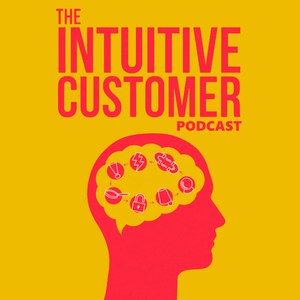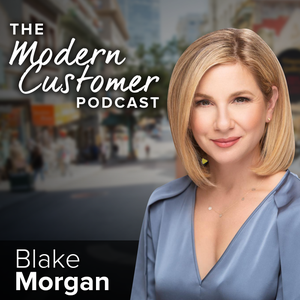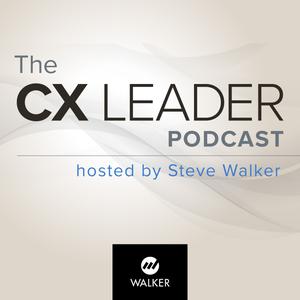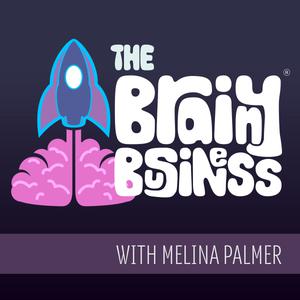
The Intuitive Customer - Improve Your Customer Experience To Gain Growth
Beyond Philosophy LLC
Improving Your Customer Experience To Gain Growth
- 29 minutes 51 secondsWhy Customers Make Instant Decisions And How To Effect it
A Master Class: Unlocking The Psychology of Customer Experience
With this episode, we begin an eight-part series exploring customer behavior and the psychology that drives it. Each part will delve into the various psychological aspects of Customer Experiences, offering practical advice on understanding and influencing them. Our focus today is on why customers make quick decisions and how you can sway those decisions in your favor.
Understanding customer behavior is complex and influenced by multiple factors, a concept known in academic circles as high causal density. There's no one-size-fits-all solution for a perfect Customer Experience transformation; it requires a combination of approaches.
Human nature often seeks shortcuts for cognitive tasks, leading to heuristic processes. Heuristics, or mental shortcuts, simplify decision-making. We discuss four common heuristics:
-
Anchoring and Adjustment: People use familiar examples to estimate values quickly, which can lead to biases, especially in pricing strategies.
-
Focusing Effect: When faced with information overload, individuals focus on crucial details to aid decision-making. Recognizing what customers prioritize can influence their choices.
-
Availability Heuristic: Our brains estimate likelihood based on easily accessible examples. Understanding what information customers readily recall helps shape perceptions.
-
Representativeness: People often categorize based on stereotypes or representative traits. Recognizing customer expectations can guide your design approach.
Considering these heuristics, we emphasize the importance of first impressions, understanding customer values, managing expectations, and aligning your design with customer decision-making shortcuts. Recognizing the diversity in customer decision-making preferences is crucial, and segmentation plays a vital role in tailoring experiences.
This episode explores various influences and group psychological concepts tied to customer decisions. Our goal is to provide a holistic understanding of experience psychology, making you more agile in grasping customer behavior and creating plans for compelling experiences that encourage return visits.
In this episode, you will also learn:
-
The significance of first impressions and their impact on customer anchors.
-
How to identify valuable areas for customers and use them for effective comparisons.
-
The role of customer expectations and how to align your design with their anticipated experiences.
-
The importance of providing information shortcuts to simplify decision-making.
-
Strategies for segmentation to cater to diverse customer decision-making preferences.
-
The overarching theme of simplification as a design approach offers customers shortcuts to decision-making and potential sales.
4 May 2024, 6:00 am -
- 30 minutes 52 secondsHow to Use Psychology to Build Customer Loyalty That Creates ROI
In this episode, Colin and Ryan tackle a listener's question about the psychology of customer loyalty, delving into its emotional and relational aspects.
Loyalty, they explain, goes beyond mere repetition of behavior; it is rooted in deep emotional attachment and often requires sacrifice. Drawing parallels to personal experiences, such as loyalty to sports teams (Lutown Town Football Club, recently reinstated in the Premiership) and brands like Apple (naturally), they highlight the importance of trustworthiness and the willingness to go the extra mile in fostering loyalty.
They emphasize the significance of loyalty in defining one's identity and sense of belonging, likening it to tribalism. Even in non-tribal contexts, individuals exhibit loyalty to specific brands or products, creating a sense of community. Through personal anecdotes and examples, Colin and Ryan illustrate how businesses can earn loyalty by prioritizing customer needs and making sacrifices for their benefit, ultimately fostering long-term relationships.
Moving beyond misconceptions about loyalty in business, Colin and Ryan encourage organizations to define loyalty in terms of sacrifices made by both the customer and the organization, fostering a two-way relationship. They offer practical strategies for fostering customer loyalty, including recognizing the emotional connection between the organization and the customer, defining loyalty for the organization, and being loyal to customers by delivering on promises and treating them with respect.
In this episode you will also learn:
-
Loyalty is rooted in deep emotional attachment and often requires sacrifice.
-
Loyalty plays a crucial role in defining one's identity and sense of belonging.
-
Businesses can earn loyalty by prioritizing customer needs and making sacrifices for their benefit.
-
Defining loyalty involves considering sacrifices made by both the customer and the organization.
-
Practical strategies for fostering customer loyalty include recognizing the emotional connection, defining loyalty for the organization, and being loyal to customers by delivering on promises.
27 April 2024, 6:00 am -
- 29 minutes 10 secondsHow to Craft Compelling Stories to Unlocking True Customer Engagement
“Did I tell you about the time I …”
These seven words are one of many ways we signal one of our favorite things is coming next: a story. We can’t get enough of stories and look for them everywhere, from news to conversations to the commercials we can’t avoid on TV. Stories are an essential part of the human experience.
In today's world, storytelling is crucial in various aspects of business, including marketing.
Human fascination with narratives stems from their ability to captivate attention, evoke emotions, and aid memory retention. Stories provide context, making information easier to recall, and create emotional connections that reinforce memory.
Businesses leverage storytelling to establish their brand identity, often highlighting humble beginnings or overcoming adversity. Effective storytelling goes beyond mere anecdotes; it persuades and simplifies complex concepts, making them relatable to the audience. For instance, Ikea's narrative of cost-saving design innovations clarifies the correlation between low price and high quality.
In marketing and persuasion, storytelling proves instrumental in communicating abstract ideas and influencing consumer behavior. By tapping into emotions and personal experiences, storytellers can make their points resonate with the audience. Stories simplify complex concepts, facilitate self-awareness, and enhance brand perception.
In this episode, we explore why storytelling is such a powerful tool in a marketer's toolbox and how you can tell compelling ones to your customers.
You will also learn:
-
The importance of storytelling in marketing and communication.
-
How narratives aid memory retention and emotional connection.
-
Examples of successful brand storytelling like how Ikea helps us buy their assemble-it-yourself furniture because it’s far more affordable that way.
-
The effectiveness of storytelling in persuading and simplifying complex ideas.
-
Strategies for crafting compelling stories, including emotional resonance and relatability.
If you have a story you want to share with us, please send us a video or audio for our None of Us Are As Clever as All of Us Feature. We’d love to hear it and might feature it on the podcast and in the newsletter.
20 April 2024, 6:00 am -
- 29 minutes 43 secondsPrivacy vs. Personalization: Striking the Right Balance to Drive Success
Personalization is an excellent tactic for your marketing efforts. However, only some people like this personalization; some feel they're being watched. Therefore, it is important to remember that context and who's doing the personalizing matter.
Picture this: Colin’s at his go-to fishing store, Discount Tackle. The manager knows him, we chat, and he recommends a lure. Even though Colin can snag it cheaper elsewhere, the personalized touch keeps him coming back.
We've all got our versions of this – the local diner, your loyal barber, or maybe a small biz that fuels your hobbies. Small businesses nail personalization. But big companies? They play the tech card, crunching data to determine "personalized" offerings—not always a slam dunk.
Why? With technology, the data sometimes gets too personal, and without a personal relationship supporting it, you're left feeling like the company is stalking you, not helping you.
The trick is to balance personalization and privacy without making it weird. Discount Tackle gets it. They add value to Colin’s fishing game. Spotify does well with personalization, too. It has cool features, like Spotify Wrapped and DJ playing mode, that enhance the music and user experience but aren't creepy.
But then there's Facebook. Facebook dives deep into Colin’s life for personalized ads, which he doesn’t appreciate, nor do they enhance his experience. Remember: we do not pay for Facebook, but they're cashing in on us.
Graham Hill on LinkedIn – he's all about putting the "customer" back in personalization. His take? Check your spam emails; they're not overly personal. He wants to see marketers’ user personalization to send the message to the right people at the optimal time.
We want personalization for a few reasons. It's like getting invited to an exclusive club when it's done right. Sainsbury's in England sends Colin discounts on stuff he buys. It is cool, not creepy. We also like familiar stuff. Plus, we appreciate the effort.
In this episode, we explore the balance between personalization and privacy. We explain why brands should always consider who you're talking to, how you're doing it, and why.
In this episode, you'll also discover:
-
The Balancing Act of Personalization: Learn how to balance personalizing interactions and avoiding the "too much information" zone.
-
The Differences Between Small vs. Big Business Tactics: Uncover how small businesses ace personalization in face-to-face talks while larger corporations use tech and the tradeoffs involved.
-
Value and Purpose Dynamics: Explore the critical role of value and purpose in personalization and how it can make or break customer relationships.
-
Why Trust and Context Matter: Understand the significance of trust and context in personalization and why it's not just about data but the emotional connection.
-
The Critical Nature of Adding Value, Not Just Selling: Shift your perspective from collecting data for sales to providing genuine value, making customers feel respected and appreciated.
13 April 2024, 6:00 am -
- 30 minutes 42 secondsDo You Really Understand Your Customer's Hidden Motivation? Here's How to Do This...
Customer emotions heavily influence experiences and motivate actions, yet these motivations are often hidden, even from the customers. Organizations must uncover these hidden motivations to serve their customers better. The "Jobs to Be Done" framework, popularized by Clayton Christensen at Harvard Business School, provides a lens through which to view customer motivations.
Eckhart Boehme, Founder and Managing Director of Unipro Solutions, emphasizes the importance of aligning customer experiences around the idea of jobs to be done, helping organizations grow faster by understanding what customers seek to achieve through their products or services.
The Jobs to Be Done framework shifts focus from product features to customer motivations, urging businesses to understand the underlying needs driving customer behavior. It prompts companies to ask what customers are buying and why they are buying it.
Boehme also introduces the Wheel of Progress, a tool designed to help organizations understand customer journeys and progress through four phases: awareness, expectations, experience, and tradeoffs. This tool facilitates collaboration and strategy formation based on meaningful data.
This episode explores why understanding customer motivations is essential for effective marketing and product design. While uncovering these motivations may not be intuitive, it is a worthwhile endeavor that can lead to powerful insights and better decision-making.
Here are five other things you will learn in this podcast:
-
The significant influence of customer emotions on experiences and actions.
-
The importance of uncovering hidden customer motivations for effective business strategies.
-
How the "Jobs to Be Done" framework provides a valuable perspective on understanding customer needs and motivations.
-
The role of tools like the Wheel of Progress in visualizing and understanding customer journeys.
-
Research and analysis are necessary to uncover customer motivations and make informed business decisions.
6 April 2024, 6:00 am -
- 30 minutes 35 secondsIs Ghosting Killing Your Sales? Here's How To Overcome It
Colin has been ghosted. He was surprised, considering he is married and has been for decades.
However, his ghosting experience didn’t come from a romantic partner but a professional one. Since ghosting appears to be spreading into many interactions, we thought we should discuss it here.
Ghosting, where someone suddenly stops communicating, has become more common, thanks to technology making it easier to cut off contact. It often happens online, like in dating apps, leaving one wondering what went wrong.
Even social invitations are not immune. Despite sending out monthly invites to friends, many don't respond, which feels rude. The ease of digital communication is eroding traditional manners.
Professional settings aren't spared either. Job candidates get ghosted by companies during interviews, and vice versa. It's surprising how these communication norms are changing, and we need to stay aware of these shifts.
Take LinkedIn, for instance. Contacting people about products or services can take time and effort. Some think not responding is rude, while others argue it's acceptable. It shows how communication norms differ across platforms.
Despite these changes, we should keep our communication personalized and well-researched. Understanding the norms of each platform and maintaining in-person connections can help avoid being ghosted. Following older norms, like sending thank-you notes after interviews, can set us apart positively.
In this episode, we discuss ghosting and why it happens. We also discuss how to navigate these changing norms with respect and awareness.
In this episode, you will also discover:
-
What ghosting is and why it happens in interactions today
-
What the primary motivation is for ghosting is
-
How understanding the norms of each platform and maintaining in-person relationships can help reduce the chances of being ghosted
-
An excellent, if time-consuming, strategy can yield the results you were hoping for if you want to access people who think ghosting is acceptable behavior
-
Why Ryan almost lost a job because he isn’t a “Thank You Note” guy
-
What type of response Colin will welcome on LinkedIn and which ones he will ignore
30 March 2024, 7:00 am -
- 31 minutes 2 secondsRevealed! The Silver Bullet of How to Improve Your Customer Experience
"What's the one thing we need for a stellar Customer Experience?"
If we had a dollar for every time clients asked us this, we’d, well, have quite a few dollars.
The question is understandable. This unspoken desire for a silver bullet solution echoes across industries. We all want a silver bullet solution that will fix our problems, whether for weight loss, financial growth, or, in Colin’s case, for playing the guitar.
The problem is that there isn’t one for CX improvement. Or guitar, frankly. Achieving mastery in guitar isn't about shortcuts—it's about hours and hours of practice. Likewise, crafting a remarkable CX demands dedicated effort, not a quick fix. Yet, the allure of a silver bullet persists.
The quest for a single, transformative action stems from a human penchant for simplicity, urgency for instant results, and an aversion to complexity. Many wish to sidestep the nuanced challenges of CX improvement, preferring an easy remedy. It's a journey fueled by a lack of CX expertise, feeling overwhelmed by the myriad CX considerations, and the appeal of past CX success stories with simple solutions.
In this episode, we explore seven reasons we want silver bullet solutions. Perhaps more importantly, we offer a realistic perspective on embracing the truth: CX improvement demands dedication and a holistic approach. By understanding the reasons behind the silver bullet mindset, businesses can navigate their CX journey with a clearer understanding and realistic expectations.
In this episode you will discover:
-
Why our psychology drives us to crave straightforward solutions, overlooking the intricacies of CX enhancement.
-
How our love for immediate results fuels the search for quick fixes and why we shy away from the multifaceted challenges in CX, seeking simplified remedies.
-
What guitar solo Colin would play if he had a magic wand, or, magic guitar pick.
-
The influence of exceptional cases and how they reinforce the belief in silver bullet solutions.
-
How our old pal Risk Aversion weighs in by leading us to seek shortcuts instead of embracing comprehensive CX strategies.
23 March 2024, 7:00 am -
- 29 minutesMaster the Art of Staying Cool: 5 Rules to Handle Customer Crises
You will have a customer crisis. We apologize for being so direct, but the fact is customer crises are inevitable. When it does happen, will you be able to navigate it to an acceptable outcome? Do you have a comprehensive approach?
We doubt it. Few organizations do.
Most think a customer crisis isn’t going to happen to them or that they will be able to manage it when it does with their business-as-usual approach.
They are wrong. It will, and they won’t.
Others think they do have a plan, even if they came up with it when the main method of communication with customers was some form of physical correspondence. They have it in a binder on a shelf back by the disconnected fax machine, just above paper files and right next to their Blackberry charger.
To be fair, they do have a plan, technically, but it lacks relevancy and will probably result in winging it at the moment of crisis.
When it comes to customer experience, even the best-managed companies encounter challenges. The inevitability of a customer crisis necessitates a proactive approach, emphasizing the art of staying composed in the face of adversity. In this pursuit, five fundamental rules emerge to guide organizations through the intricate landscape of customer crises.
We share these rules and why they will help in this episode. The journey through customer crises demands a holistic and proactive approach. By embracing these rules, organizations can navigate the complexities of customer crises with composure, transparency, and a commitment to continuous improvement.
Here are some of the things you will learn:
-
Starting with the obvious, we make the case that a well-thought-out plan is essential in managing customer crises effectively and that you likely have the foundations of one built already in your present customer service scheme.
-
We share how reminding cruise passengers a watery death on the journey is a possibility by having an evacuation drill upon leaving port is a great way to start the cruise experience—and a relationship built on trust.
-
We explain how actively listening to customers and showing empathy is critical to maintaining composure during a crisis, especially for frontline employees, who face the barrage of raw, disappointed customer emotions first.
-
Why news should always be shared, good or bad, and that transparency and honesty take precedence over withholding information during a crisis.
-
The essential nature of reviewing the whole problem, what you learned, and how you plan to avoid it happening again in the future will move your customer relationships forward in a positive way once the negative incident is behind you.
16 March 2024, 7:00 am -
- 29 minutes 10 secondsOvercoming Gridlock in Decision Making: Unraveling the Paradox of False Consensus
Have you ever come across the Abilene Paradox? It's when everyone agrees to do something that no one really wants to do.
Jerry B. Harvey coined "The Abilene Paradox" based on a family incident. They ended up driving 50 miles each way across the scorching Texas desert to Abilene for dinner, even though none of them wanted to go. They all thought everyone else wanted to go, so they reluctantly agreed. Politeness led them to a hot, dusty adventure that none of them enjoyed.
This reminded me of a recent experience. I had plans with friends, but as the weekend neared, I wasn't up for it. I decided to bow out and texted the group. Surprisingly, many others in the group thanked me for speaking up because they didn't want to go either. It made me wonder who initiated the plan in the first place.
In work settings, I recall something similar. I remember being in meetings where the boss suggested something not so great. Nobody spoke up because, well, the boss is the boss. Challenging the boss could make someone look foolish, so everyone went along. This conformity can lead organizations down a problematic path.
So, what can you do to avoid the Road to Abilene?
This episode explores how to avoid such situations in your organization. The good news is there are effective ways to manage it, with strong leadership and a robust communication process being crucial.
In this episode, you will also learn:
-
The various reasons we find ourselves in such situations that often involve avoiding conflict, fearing consequences, or having poor communication systems within the team.
-
How to encourage open communication and foster an environment where team members feel safe expressing their opinions without fear of backlash.
-
What the benefits are of constructive dissent, where leadership encourages team members to voice differing opinions and ideas, leading to better decisions and avoiding the pitfalls of silent conformity.
-
Which essential leadership skills matter most here, and why there is value in listening to diverse perspectives
-
The specific strategies organizations can use to avoid falling into the Abilene Paradox trap, ensuring that decisions and plans are based on genuine agreement and understanding.
9 March 2024, 7:00 am -
- 34 minutes 17 secondsHow to Measure the Hidden Impact on ROI of Evoking Customer Emotions
A hidden impact exists regarding your experience management return on investment (ROI). It is often overlooked because it lurks between a specific moment in a customer process and the behavior resulting from it. However, uncovering and understanding this hidden impact is critical for comprehending its implications on the bottom line.
Emily Davidson wanted to know how to determine the value of her Customer Experience initiatives, a challenge many in the field face. So, she asked us—and we were glad to tell her. What Emily needs is the insight provided by our Emotional Signature research.
The Emotional Signature was developed years ago in collaboration with the London Business School. It resulted from millions of questions posed to thousands of business professionals across hundreds of countries, leading to the identification of the Emotional Signature®.
The Emotional Signature gauges how experiences make individuals feel and how those emotions correlate with the value assigned to the experience. For instance, an experience infused with friction and frustration might yield an Emotional Signature that disappoints customers, resulting in undesirable behavioral outcomes. Conversely, positive emotional connections can enhance outcomes.
Emotions drive customer behavior, influencing actions beyond what survey responses might indicate. A case in point is how Disney Theme Parks discerned that guests, when surveyed, requested salads, but their behavior demonstrated a preference for junk food. This discrepancy showcases the nuanced nature of customer desires and the importance of understanding the specific feelings driving behavior.
In this episode, we explain to Emily and our other listeners how the Emotional Signature Research provides a data-driven approach to understanding the intricate relationship between emotions, customer behavior, and organizational values. While optional for those already convinced of the emotional impact on customer behavior, it is a powerful tool for skeptics requiring tangible evidence before investing resources in experience improvements.
In this episode, you will discover the following:
-
The key to measuring emotional impacts on ROI is how organizations often don’t even know when you ask them and how you can figure it out for your organization.
-
The twenty emotions, ranging from joy to frustration, that drive or destroy value for organizations.
-
Why granularity about customer emotions is crucial, and why the ubiquitous oversimplification of emotions as positive or negative won’t work.
-
A basic explanation of Structural Equation Modeling, a widely accessible statistical technique, and who to assign it to on your team (hint: it’s the one who is best with numbers).
-
How sorting through what customers say they want but don’t drive value and what customers don’t say they want but do is crucial for making informed decisions that impact the bottom line positively.
2 March 2024, 7:00 am -
- 32 minutes 6 secondsPsychology of Buying: Why 'Mental Accounting' is Critical to the Decision to Buy
Have you ever noticed that spending cash is harder than using a credit card? You are not imagining things. Different payment methods carry varying degrees of discomfort when used.
Cash tends to have the most painful impact, followed by checks. Credit cards offer a lesser discomfort than cash or checks. With advancements in payment technologies like contactless cards or smartphone transactions, the potential exists for these methods to generate even less discomfort than traditional credit cards.
So, how can businesses leverage these insights into payment methods to assist customers in handling their emotional response to spending?
To put it simply, the answers lie in Mental Accounting and Reframing.
Mental Accounting plays a pivotal role in how customers navigate their emotions regarding spending. It serves to alleviate guilt and elevate happiness in spending scenarios. Thus, it's crucial to consider mental accounting within the broader context of managing customers' emotional experiences.
In this episode, we explore where your customers are emotionally relative to the purchases they make and how guiding them to an improved mental accounting from your business perspective is essential. It turns out that messages that acknowledge and address customers' emotional responses to spending can be a powerful strategy in enhancing their overall satisfaction and engagement during transactions.
Here are some other key moments in the discussion:
-
04:09 Ryan explains how money can be spent on anything, however the biases we create using mental accounting help us manage our emotions regarding our spending.
-
07:20 Colin associates a podcast with Joe Pine regarding how customers value their time in experiences differently depending on the type of timed transaction it is.
-
17:43 We discuss the importance of understanding what mental accounting your customers are using and working with that to help them feel more satisfaction with their purchase.
-
21:08 We explore how financing in the mix can change the spending experience for customers.
-
28:09 We share the key takeaways from Mental Accounting and how you can leverage it to improve your experiences with customers.
About Colin Shaw
LinkedIn recognizes Colin Shaw as one of the 'World's Top 150 Business Influencers.' As a result, he has over 294,000 followers and 78,000 subscribers to his LinkedIn newsletter ‘Why Customers Buy’. The Financial Times selected Beyond Philosophy as one of the best management consultancies for four years.
Colin is a renown keynote speaker and undertakes consultancy work and educational workshops to help organizations improve their Customer Experience.
Click here to learn more about Professor Ryan Hamilton of Emory University.
How can we help?
Click here to learn more about Beyond Philosophy's Suite of Services.
Please tell us how we are doing! Complete this short survey.
24 February 2024, 7:00 am -
- More Episodes? Get the App
Your feedback is valuable to us. Should you encounter any bugs, glitches, lack of functionality or other problems, please email us on [email protected] or join Moon.FM Telegram Group where you can talk directly to the dev team who are happy to answer any queries.
 The Modern Customer Podcast
The Modern Customer Podcast
 The Chief Customer Officer Human Duct Tape Show
The Chief Customer Officer Human Duct Tape Show
 Customer Experience Leaders
Customer Experience Leaders
 The CX Leader Podcast with Steve Walker | A resource for customer experience leaders
The CX Leader Podcast with Steve Walker | A resource for customer experience leaders
 The Brainy Business | Understanding the Psychology of Why People Buy | Behavioral Economics
The Brainy Business | Understanding the Psychology of Why People Buy | Behavioral Economics
 The CX Cast®
The CX Cast®